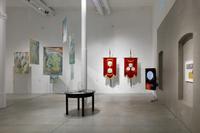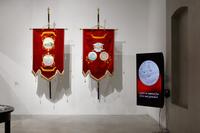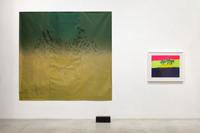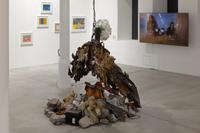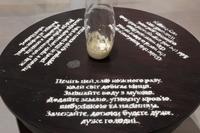On Renewed Land: Locating Ukrainian Destiny
Translated by Marta Darom
Curatorial essay on the exhibition.
Let the long. Road. Lead. To. Stairs in. The Heavens
9/2–16/4/2023, PLATO
Future during war
Our team was first approached in September 2022 about curating an exhibition of contemporary Ukrainian art at PLATO Ostrava. This proposition gave us pause. Following Russia’s full-scale invasion of Ukraine on February 24th, 2022, curatorial projects connected with Ukraine have had to cope with the double bind of addressing the constant developments of the ongoing extraterritorial state violence perpetrated by a neo-colonial aggressor, while also justifying the very validity of artistic, curatorial, and cultural practices in the midst of such a cataclysm. Exhibition topics that are staples of contemporary discourse, and which have produced some of the most valuable reference points for curatorial practice, quickly become trivial in the face of shelling, torture, mass deportation, and the innumerable other war crimes committed daily in Ukraine by the Russian state.
How might one imagine an exhibition six months in the future, when plans for our own lives are impossible in that same timeframe? How can one address the theoretical—not to mention the technical—needs of a project proposed for a moment in time that is obscured by the unpredictability of the present? In one particularly poignant conversation on the topic of addressing the future in an exhibition context, one Ukrainian writer curtly responded: “Future? It’s bullshit. Right now there is no future.” Many others have echoed this sentiment, and it is still difficult to disagree. As long as Russian rockets continue to rain down on Ukrainian lands, the future is dark. Despite this grim knowledge, this response should not be construed as overly pessimistic. While on the surface it appears to signal a certain nihilism (in which case it might be more fully articulated as “there is no hope for the future”), her sentiment—and that of many Ukrainians—might be more accurately understood as a question of precognition (there is a future, but that future cannot be seen). It is this collective knowledge that Ukraine definitively does have a future, that is the notion of destiny that anchors this exhibition.
Ukrainians continue to live, and thrive, and resist, despite Russia’s most explicit attempts to erase them and their futures. We acknowledge that despair cannot be fully banished from the minds of those affected by the war, but it would be a grave mistake to assume that despair on the part of the Ukrainian people is a dominant feature of this war. On the contrary, hope, the antonym of despair, seems to rule the day. In this sense, while war makes the futures of those it affects elusive, the tenacity of Ukrainian hope speaks to a vision that cannot be eluded. What is more, we know that times of great uncertainty require a vision for survival, and survival is the essence of all futures. While destiny is many things in this exhibition, it is, above all, visionary. These artistic works speak to us precisely because they are not bound by the constraints of that unseeable future—or this troubled present.
Destiny during war
It is important to note that destiny is not always benign, and envisioning any nation that exists extemporally cannot be an unqualified gesture. As any student of the ideological underpinnings of Russia’s colonial violence knows, destiny has long been present in its conversations about Ukraine. From foundational myths co-opting the history of the Kyivan Rus, to the ethno-essentialist fantasy of brotherly nations, Russian crimes have been predicated on the exploitation of a destiny-adjacent political will to power, in which Ukraine is both sacred heartland and alien to the point of total dehumanization. Any discussion of destiny during war must firmly reject the colonial degradation of the idea into manifest destiny, that unholy justifier of atrocities and imperialist aspirations.
Russia’s rhetorical use of these tropes is not coincidental. As argued by Timothy Snyder, the fascist evolution of the Russian state and its kleptocratic strongman Vladimir Putin is a direct expression of a political trajectory that is deeply inflected by temporal elements drawn from the same precognitive pool as our exhibition’s concept of destiny. Snyder’s politics of inevitability (as expressed in the socialism of the pre-Brezhnev Soviet Union) and politics of eternity (as expressed in the ahistorical embrace of fascism during Putin’s second round in office)1 both seek to solve the problems of time and future in different ways, but both use a promise of something atemporal to lull adherents into a denial where blatant losses of freedom and quality of life are incompatible with a received reality constructed by the state. In the former, the Soviet utopian promise of fully achieved communism was the hollow beacon directing the repressive violence of the USSR’s politics of inevitability. In the latter, the victimhood and the mystical virgin innocence of the Russian people are the core of a destructive grievance politics that the Russian state uses to fill the void of its own failure as a political project. In both cases, time-based concepts adjacent to destiny (inevitability and eternity) wither the state and corrupt the society into complacency towards—or even celebration of—state violence.
Any current discussion of a Ukrainian destiny, therefore, must acknowledge the perversity and corrupting power of these destiny-adjacent ideas, which have directly led to the genocidal invasion that has thrown the Ukrainian people’s struggle for survival into hyper-relief. This is itself an indignity, because in more peaceful circumstances, independent Ukraine’s state project has been about discovering the depth and breadth of Ukrainian identity as something not simply defined by external imperial and colonial forces. This decolonial undertaking, especially in culturally generative fields like contemporary art, has been carried out in historical conversation with—rather than dictated by—relationships with its neighbors. To draw on Snyder’s work again, defining the state through the identification of enemies is in fact the fascist root of current Russian politics. While Ukraine as a nation incorporates many political tendencies, as do all democratic units, it has continually defined itself most effectively through self-reflection and freedom of association, rather than fascistic negation. Ukraine is a complex and multifaceted sovereign nation. Ukraine is not defined by enmity towards what is external to it.
Destiny as a container
In Let the long. Road. Lead. To. Stairs in. The Heavens, Ukrainian destiny is endlessly generative. It is a destiny that populates the spaces of possible futures and pasts by capturing and articulating nodes of inspiration out of the boundless constellation of Ukraine’s artistic potentialities. If this sounds unmanageably cosmic, it is. When expressed in this exhibition, however, the stubborn conundrum of defining Ukrainian destiny’s multifarious character has its own implications as an anti-fascist undertaking, in that it opposes the tyranny of linear and rational organization. In another recent discussion with Ukrainian friends about the exhibition, a suggestion arose that the temporary capture of these varied expressions might fit well into a container similar to the carrier bag of fiction described by Ursula K. Le Guin2. While we affirm that Ukrainian destiny is no fiction, Le Guin’s formulation is helpful precisely because it pushes back on interpretive tendencies that our exhibition also hopes to overcome. Her ideas of narrative are decidedly (if not explicitly) anti-fascist. People, a multitude of gazes, experiences, and intersecting paths constitute a narrative replacing the violent tradition in which heroes, villains, and conflicts tend to define a story—or, with unfortunate frequency, a history. This adversarial narrativization of the world, when viewed through Snyder’s lens, reveals itself as patently fascistic. Conversely, Le Guin’s carrier bag helps us decenter and emancipate the great narratives not only of fiction, but also of historical fact.
The metaphor of the carrier bag is also about the future. For the prehistoric proto-societies imagined by LeGuin, everything is of the moment—hunger, thirst, sun, rain, snow, cold, hot, strength, illness, love—until it is placed inside a container. The container transports this object into a future, and with that future, vision appears. Tomorrow has promise with a piece of food wrapped in a leaf, journeys can be undertaken with a tanned bladder filled with water, weather can be endured with warm clothes in a bundle, ailments can be cured with a medicine pouch or pot of ointment, sentiment can endure by tucking an object of devotion away for safekeeping, a future society can be built when cultural objects are preserved, and—vitally for this project—a destiny can be envisioned inside the container of a gallery’s walls. This should not be mistaken as materialism. As with Ukraine’s immaterial but palpable destiny, the essential element that matters most is not the thing itself, but the ideas born of the surety that tomorrow there will be something, and that something spells survival. In this sense, all expressions of destiny on view in this exhibition become microfacets of the greater will to live.
And there will be people on the land
A fundamental aspect of this exhibition is that, while we hope its ideas will be specifically of your moment, we have sought to establish that until you read these words, that moment is unseeable for us. Put more succinctly, by being present and viewing these works, you are proof of precisely the future that we cannot see. It is now your responsibility to search for the shape of Ukrainian destiny in the works of these artists who have made it their practice to persevere against the adversity of war. If you listen, their works speak, and with the help of prescient texts by the Ukrainian witch Frosiko, their power, depth, and extratemporal connectivity are made apparent. Frosiko’s texts should be read with care, because they serve as a medium not just for the voices of the exhibited objects, but for the voices of previous, and perhaps future, works of Ukrainian destiny. Such sensitive, poetic, and predictive words are part of a longer history in the Ukrainian artistic tradition which continues to flow through the generations.
As potentially destined proof of this fact, we offer a few closing words that speak to this greater continuity. On a recent visit to Dnipro, our team encountered a fresh test print tacked to a door in the studio of Serhii Aliev-Kovyka, an artist who is active today in contemporary circles, but who hails from the last generation of artists to come of age in the Soviet Union. The linoleum-cut words emerge from a time when the boundaries of destiny and future may also have been in flux:
І на оновленій землі
Врага не буде, супостата,
А буде син, і буде мати,
І будуть люде на землі.
And on renewed land
There will be no enemy, no opponent,
And there will be a son, and there will be a mother,
And there will be people on the land.
This poetic vision, penned by Taras Shevchenko more than a century and a half ago, may be separated from us by generations, political formations, and, tragically, much war and suffering, but in the context of the exhibition’s larger conceptual thrust, it appears remarkably current. A Ukraine in which there will be “no enemy, no opponent” is a Ukraine that is not defined by antagonisms, and as such, exists today in the anti-fascist and decolonial paths that inspire these artworks. The promise of the “son”, the “mother”, and the “people” exists in the container formed by the bodies and minds of these nine artists. Lastly, as Ukrainian history has attested, renewal exists not just figuratively, but endlessly and irrepressibly, in the Ukraine that is now and that will be. In this artistic voice from generations past, together with the voices of the new generation gathered here, a Ukrainian destiny definitively exists.
Author’s note: We would like to thank the many Ukrainian artists and writers whose influence is felt in this exhibition, and specifically Kateryna Iakovlenko, Lisa Biletska and Philip Olenyk, and Serhii Aliev-Kovyka for the conversations that shaped this text.
←→
- Language
- Type
- Palate Cleanser2025
- cs
- en
text- 2,000 words
- Monika Pascoe Mikyšková: Memories that aren’t mine2025
- cs
- en
text- 500 words
- Kino Kosmos under the Cosmic Sun2025
- cs
- en
text- 9,800 words
- Kino Kosmos2025
- cs
- en
text- 3,700 words
- Dorota Jurczak: Pyk, Sciak etc.2025
- cs
- en
text- 1,500 words
- Sprouts2025
- cs
- en
text- 800 words
- Curatorial text for the exhibition by Petr Bosák, Robert Jansa and Adam Macháček2025
- cs
- en
text- 900 words
- Curatorial text for Martin Zetová's exhibition2025
- cs
- en
text- 1,100 words
- Cello & Piano2025
- cs
- en
audio - Primeval Forest, Garden and Wall2024
- cs
- en
- pl
text- 1,100 words
- Interview with Barbora Lungová2024
- cs
audio - Barbora Lungová and the gift of painting2024
- cs
- en
text- 1,400 words
- Julie in the Worlds of Fantasy. Marginalia.2024
- cs
- en
text- 1,600 words
- Pigeon newspaper2024text
- Workbook for children The Shell No. 32024
- cs
- en
text- 200 words
- Zvířecí kustodi – Bee2024
- cs
- en
video- 32’32”
- Animal Custodians – Rabbit2024
- cs
- en
video- 33’18”
- Animal Custodians – Owl2024
- cs
- en
video- 28’05”
- Animal Custodians – Fox2024
- cs
- en
video- 32’05”
- Animal Custodians – Deer2024
- cs
- en
video- 33’45”
- Animal Custodians – Pigeon2023
- cs
- en
video- 32’20”
- Animal Custodians – Raven2023
- cs
- en
video- 21’24”
- If you have a canary with a poor singing voice, it will never stop singing after this training video!2023
- cs
- en
video- 21’24”
- Checking the Stove2023
- cs
- en
video- 5’34”
- 0’40”
- Trust2023
- cs
- en
video- 7’03”
- Is it the flight or the fall what my friend is falling for?2023
- cs
- en
video- 12’08”
- Animal News2023
- cs
- en
text- 1,500 words
- Dan Walwin: Relief2023
- cs
- en
text- 1,000 words
- Ukrainian Culture at the Time of Russian Aggression2023
- cs
- en
text- 100 words
- Freely Accessible Books on the Topic of Ukrainian Culture at the Time of Russian Aggression2023
- cs
- en
text- 500 words
- They Thought We Were Alive and They Run Screaming2023
- cs
- en
text- 1,200 words
- On Renewed Land: Locating Ukrainian Destiny2023
- cs
- en
text- 1,900 words
- I Can Hear the Grass Grow2023
- cs
- en
text- 600 words
- Interview related to the exhibition Optimised Fables about a Good Life2022
- cs
- en
text- 900 words
- Interview related to the exhibition Optimised Fables about a Good Life2022
- cs
- en
text- 900 words
- Interview related to the exhibition Optimised Fables about a Good Life2022
- cs
- en
text- 700 words
- Interview related to the exhibition Optimised Fables about a Good Life2022
- cs
- en
text- 1,700 words
- Interview related to the exhibition Optimised Fables about a Good Life2022
- cs
- en
text- 1,000 words
- Interview related to the exhibition Optimised Fables about a Good Life2022
- cs
- en
text- 1,100 words
- Interview related to the exhibition Optimised Fables about a Good Life2022
- cs
- en
text- 900 words
- Interview related to the exhibition Optimised Fables about a Good Life2022
- cs
- en
text- 1,600 words
- Interview related to the exhibition Optimised Fables about a Good Life2022
- cs
- en
text- 900 words
- Interview related to the exhibition Optimised Fables about a Good Life2022
- cs
- en
text- 1,400 words
- The Night2022
- cs
text- 0 words
- Optimised Fables about a Good Life2022
- cs
- en
text- 800 words
- In the footsteps of the Greek underground II: Longing for deep time2022
- cs
- en
text- 7,200 words
- In the footsteps of the Greek underground I2022
- cs
- en
text- 12,800 words
- Elective Affinities: “Anarchism Without Adjectives”. On the Work of Christopher D’Arcangelo 1975–1979 with Dean Inkster and Pierre Bal-Blanc2022
- cs
- en
video- 58’01”
- Curatorial Control2022
- cs
- en
text- 2,500 words
- Ruins. Reconstruction of the past and construction of the future2022video
- 1h 14’43”
- Long Evening with Octopus Press2022
- cs
audio - Oh and Hah, Beauty, Ruin and Slack2021
- cs
- en
text- 900 words
- Our Living Ruins2021
- cs
- en
- pl
text- 3,100 words
- Troubling Time/s and Ecologies of Nothingness: Re-turning, Re-membering, and Facing the Incalculable2021
- cs
- en
text- 16,400 words
- Re/un/doing the Ruin2021
- cs
- en
text- 2,800 words
- Usableness of the list / Portfolio2021
- cs
- en
audio - Tied to Landscapes2021
- cs
- en
text- 800 words
- Tied to Landscapes2021video
- 9’49”
- A Small Encyclopedia of Improprieties2021video
- 12’18”
- Humans need not apply2021
- cs
- en
text- 900 words
- Poems2021
- cs
- en
text- 200 words
- Carbon Care2021
- cs
- en
text- 1,400 words
- Bouvard and Pécuchet. A Tragi-comic Novel of Bourgeois Life2021
- cs
- en
- fr
text- 12,300 words
- And Again G. F.2021
- cs
- en
text- 700 words
- On The Immortality of Art Institutions2021
- cs
- en
- pl
text- 1,500 words
- Expedition PLATO2021video
- 47’25”
- The Great Transformation. The Political and Economical Origins of Our Time2021
- cs
- en
text- 4,800 words
- Digestive Tract2021video
- 14’35”
- Notre Dame of Ruins2021
- cs
- en
- fr
text- 1,100 words
- Who is Afraid of Ruins?2021
- cs
- en
- pl
text- 1,300 words
- The Ruin2021
- cs
- en
- de
text- 3,000 words
- Zapomínání a infrastruktura2021video
- 13’19”
- Forgetting and infrastructure2021
- cs
- en
text- 2,000 words
- Olympia2021image
- Purification II, 20202021video
- 3’35”
- Purification I, 20202021video
- 1’49”
- Chaos: how to ruin a ‘ruin’ and love a ‘ruin-in-love’, I think2021
- cs
- en
text- 5,400 words
- (Introduction) Chaos: how to ruin a ‘ruin’ and love a ‘ruin-in-love’, I think2021video
- 13’35”

